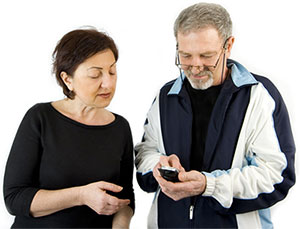Protect Your Privacy on Your iPhone
 These days more and more people are beginning to use their smart phone as their main tool for browsing the web, transferring documents, sharing and storing personal pictures, and managing financial accounts.
These days more and more people are beginning to use their smart phone as their main tool for browsing the web, transferring documents, sharing and storing personal pictures, and managing financial accounts.
There is also an increasing use in the workplace. A smart phone can be a treasure trove of personal information and proprietary work information that can be exploited for financial or personal gain. Sensitive data can be found in a multitude of places on your iPhone:
- Private emails containing passwords to other accounts, financial account information and attachments containing sensitive information such as a tax return;
- Work emails containing confidential business communications, intellectual property or protected customer information;
- Should your iPhone passcode be bypassed or left unlocked, a thief can use apps installed on your phone to manage bank or financial accounts and other sensitive transactions; and
- Pictures in the iPhone camera roll may be of a private personal nature or contain scans of sensitive documents for personal or professional use.
Unfortunately, many people don’t realize just how much personal information is accessible via their iPhone and don’t take necessary steps to protect it. Sometimes people go beyond failing to take protective measures and actually take proactive measures to reduce the security of their iPhone.
For example, many people opt to “jailbreak” their device which entails the owner making unauthorized modifications to the operating system of the phone. These modifications allow users to download apps or perform other tasks normally not allowed by the iOS. This can result in severely reduced security measures that come with the iOS in order to protect your personal information and ward off malware targeted at your iPhone. (Yes, there is malware designed to attack iPhones).
The latest iPhone has a fingerprint scanner that can be used to unlock your iPhone in lieu of entering a four digit passcode, but was successfully hacked about two days after the iPhone 5s was released.
New hacks and tricks are discovered every day by white hat hackers looking to expose iPhone’s vulnerabilities so that Apple can resolve them. Many of these hacks are short lived as Apple is good at providing updates to close security loopholes when they are discovered, but they continually surface and this requires vigilance on the part of the iPhone owner to stay up to date on iOS updates. These hacks often include methods to bypass the unlock passcode to access limited capabilities of the iPhone via Siri or the control panel.
While there is no surefire way to avoid having your iPhone hacked, there are many ways to reduce your chances of unauthorized access:
- Keep your iOS updated and be quick to install the updates as soon as they become available;
- Disable access to Siri and Passbook while the phone is locked by navigating to Settings -> General -> Passcode Lock and switching Siri and Passbook to off;
- Disable access to the Control Center while the phone is locked by navigating to Settings -> Control Center and turning off the “Access on Lock Screen” option;
- Should you decide to use the fingerprint scan option to unlock your phone, use it in conjunction with a four digit passcode to increase security;
- Whenever browsing the web using free WiFi in a public place, use a VPN service to prevent thieves from monitoring your Internet activity; and
- Always have your iPhone passcode lock activated and consider using the auto-lock feature to avoid accidentally leaving your phone unlocked in a public place.
(“Protect Your Privacy on Your iPhone" was written by Sam Imandoust, Esq., CIPP, CIPA. He serves as a legal analyst for the Identity Theft Resource Center.)